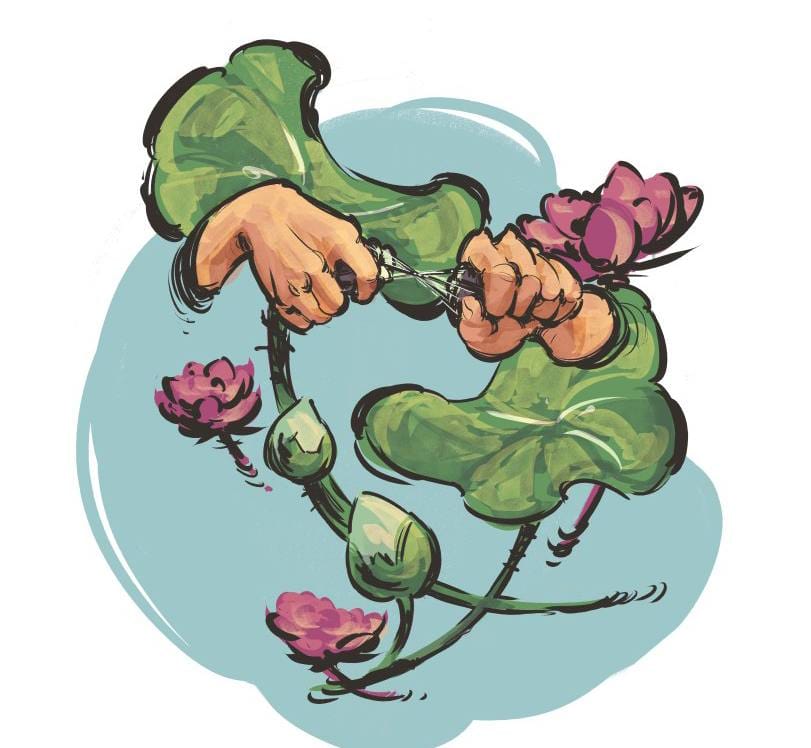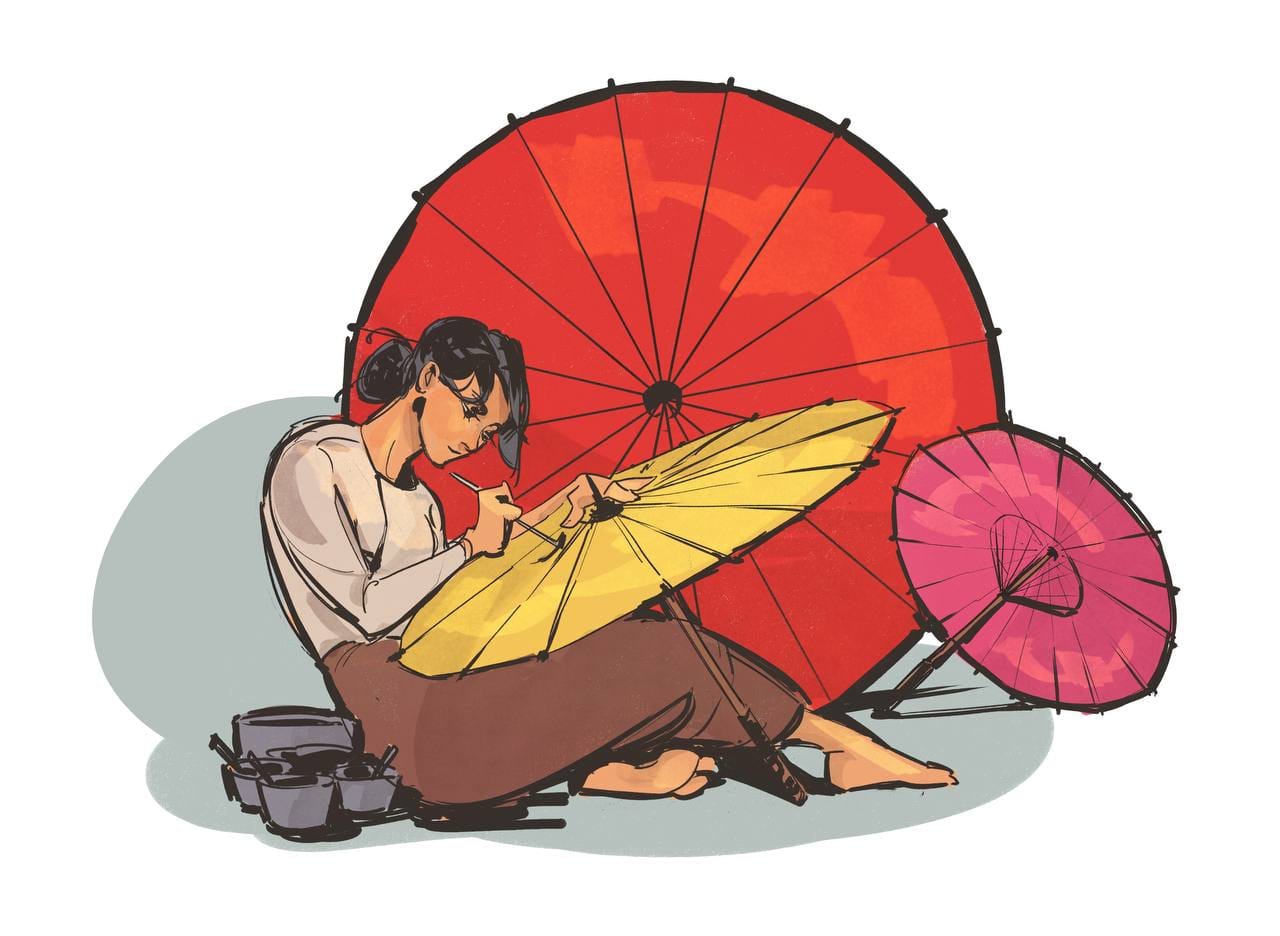
A jacket from Italian designer Pier Luigi Loro Piana's Loro Piana Lotus Flower brand costs $6,500. Why is this jacket, which looks like an ordinary cotton jacket, so expensive? What makes it so special?
The answer is that it's made from lotus fiber. Lotus fiber refers to the natural fiber extracted from lotus stems. Don't be surprised to learn that the lotus fibers used in this $6,500 jacket were extracted one by one by hand by a young female weaver from Inle region, Shan State, Myanmar. Yes, the main raw material for Italian designer Pier Luigi Loro Piana's lotus fabric clothing comes from Myanmar.
Lotus fiber, which is about 10 times more expensive than ordinary cotton, is among the world's most valuable fibers. This valuable fiber is produced in Myanmar. It has long been known that Myanmar's natural resources have a good reputation as a world-class resource.
However, few people know about lotus fiber. Myanmar's lotus fiber production has a history of about 100 years.
Where did Myanmar's lotus fiber begin?
Before talking about lotus fiber, it's important to first discuss the lotus flower. In Myanmar, the lotus is a flower with religious symbolism. It represents success, peace, freshness, dignity, and purity. There's a Myanmar saying that "a well or pond is only beautiful with lotuses."
The lotus is useful in its entirety for Myanmar people. The stem is used to extract fiber, the flower is offered to Buddha, the leaf is used for wrapping and preparing food, and the seeds and roots are eaten. The lotus flower is uniquely involved in Myanmar society in this way. It's interesting that they were able to produce lotus fiber from this revered lotus flower.
Tracing history, we can firmly say that lotus fiber originated from Inle. These days, some people even think lotus fiber started in Vietnam. The reason is that the lotus flower is Vietnam's national flower, and Vietnamese lotus fiber has also been gaining a place in the international market.
In fact, Vietnam only began lotus fiber production around 2017. Myanmar, on the other hand, has been producing lotus fiber since about 100 years ago (early 20th century), according to the "Lotus Fiber Value Chain in Myanmar" paper prepared by the Regional Bio-trade Project.
The first person to discover how to produce lotus fiber from lotus plants was Daw Sa Oo from Inle. Because she was able to pioneer the invention of lotus fiber, Daw Sa Oo is also called Daw Kya Oo.
The way Daw Kya Oo discovered lotus fiber, which is the world's most expensive fiber, was very simple. Daw Kya Oo, a villager from Kyaing Kan village in Inle, Shan State, was picking lotus flowers one day to offer at the temple. While picking, she noticed fibers coming out of the lotus stem. She thought it would be great if these little lotus fibers could be woven into thread. So she cut the lotus stem into manageable pieces and tried to turn the resulting lotus fibers into thread. She wove the resulting lotus threads into robes. She donated the first lotus robes to the Shwe U Daung Mountain Sayadaw and the Phaung Daw Oo Pagoda in Inle. This is how lotus fiber production began in Myanmar.
From lotus stem to lotus fiber
Although lotus fiber is produced from lotus stems, not all lotuses can be used to produce lotus fiber. Among the five types of lotuses - white lotus, red lotus, purple lotus, kumudra lotus, and paduma lotus - only the paduma lotus can be used to produce lotus fiber. The other lotuses don't produce quality fibers suitable for thread production. Only the paduma lotus, which is pink and has large petals, can produce the best quality fiber.
In the past, they used to pick naturally growing lotus flowers to produce lotus fiber. Nowadays, people are cultivating lotuses themselves. However, lotus fiber can't be produced easily at any time. There's something called lotus quality. Lotus quality depends on the weather.
There's a Myanmar saying, "Lotuses are beautiful when the water is high."
Lotus fiber production is the same as this saying. The higher the water, the better the quality of the lotus. When the water level drops, the mud thickens and the quality of the lotus decreases. Lotuses have the best quality only during the rainy season. Although lotus fiber can still be produced in the less rainy winter, the quality isn't as good as the lotus stems from the rainy season. Therefore, the best time to produce lotus fiber is only during one rainy season.
To produce lotus fiber, the lotus stem is cut between 5 AM and 10 AM. When cutting the lotus stem, they don't use the stem with the flower. They only cut the stem with the leaf. The way of preserving the obtained lotus stems varies slightly. Some soak the lotus stems in water for two nights. Or they cover them with wet towels for two nights. Then they extract the lotus fiber within ten days. Some extract the lotus fiber within 24 hours. Although the methods differ, the main similarity is that they need to maintain the moisture of the lotus. If it dries out, the fiber won't come out.
When extracting lotus fiber from the lotus stem, all you need is a sharp blade and a wooden board. But this process requires skill. The lotus stem is cut into about four-inch pieces with the blade, and then the lotus fiber is pulled by hand onto the wooden board. At this time, the underlying wooden board must be moist with water, and the hand's timing must be neither too strong nor too weak. If you can't calculate the timing of your hand, the lotus fiber might break or not stick to the wooden board. The quality of the lotus fiber depends a lot on the skill of the fiber extractor.
The resulting lotus fibers need to be pulled repeatedly until they become thick and strong. When the desired thickness is achieved, it can be rolled by hand to make lotus thread. To make the resulting lotus thread more durable, natural glue and wax are used to rub the lotus thread. Then it's wound on a spool and naturally dried in the shade. If color is desired, natural dyes from fruits and tree bark are used. Once the lotus threads are dry, they can be put on a loom after being wound on a bobbin.
Just as lotus fiber is difficult to produce, getting a fabric made from lotus fiber is not easy either. For a scarf, about 4,000 lotus stems are needed, and for a lotus cloth shawl that is 7 inches wide and two yards long, about 8,000 lotus stems are needed. The weaving time takes at least a month and a half. For a lotus robe, about 200,000 lotus stems would be needed.
Lotus fiber, which is so difficult and delicate to produce, still has unique characteristics unlike any other fiber. We can call these the properties of lotus fiber. These include that lotus fiber can adjust to the temperature of the human body. It can change its resistance according to weather conditions. Lotus fiber is cool in summer and warm in winter. It's lightweight and has exceptional softness. It's water-resistant. The fiber has the scent of lotus flowers.
That's why lotus fiber is among the world's most expensive and rarest fibers.
Lotus Fiber and Women
When talking about lotus fiber, it's necessary to include women's involvement. The first person to start lotus fiber production was a woman, and the main people involved in the lotus fiber production and lotus fiber weaving process are also women.
In the past, the person who cut the lotus stem for lotus fiber production had to be a man. If it was a woman, she had to be unmarried, a virgin. This maiden had to observe the five precepts. She had to be physically clean. During the menstrual cycle, she couldn't cut lotus stems. If these rules weren't followed, it was believed to interfere with lotus fiber production. The lotus fiber yield would be low and the lotus stems would break easily, according to local beliefs. But as times and systems have changed, nowadays married women are also cutting lotus stems and weaving lotus fiber.
There are about 12 to 14 steps from lotus stem to lotus fiber. Throughout this process, women's involvement is estimated to be over 80 percent. Lotus fiber is not only a job opportunity for local women but also a genuine handicraft of local women.
Where is Myanmar's lotus fiber heading?
At the 71st Miss Universe pageant held in 2022, Myanmar beauty queen Zar Li Moe competed wearing a national costume called "Queen of Lotus," a lotus flower costume. This costume sparked criticism and interest among the audience.
Many people became interested in how Myanmar is related to lotus fiber. Because of beauty queen Zar Li Moe's lotus flower costume, people also became interested again in Inle's lotus fiber production.
Although lotus fiber was mainly produced only in Inle in the past, now it's also being produced in Sun Ye Inn in Sagaing, Inn Ma Kan in Sauk Kun, and Wet Htee Kan in Salin. However, only Inle can produce lotus fiber as a finished product. Therefore, Myanmar's lotus fiber product is still progressing slowly with limitations.
In Inle, the villages mainly producing lotus fiber and lotus fiber textile products are Kyaing Kan village and Inn Paw Khone village. In the past, they only produced lotus robes made from lotus fiber, but now they are also producing shawls, scarves, and blankets. In addition to these, there are also finished products made by mixing lotus fiber and silk. However, Myanmar's lotus fiber finished products are more expensive and lagging in progress compared to regional countries that can produce lotus fiber like Cambodia and Vietnam.
In 2017, Vietnam began producing lotus fiber. Phan Thi Thuan, a woman who runs a silk business, was the one who started producing lotus fiber after seeing lotus fiber from lotus stems, just like Daw Kya Oo. When she started weaving lotus fiber, she studied the lotus fiber production of Myanmar and Cambodia. Since the lotus flower is Vietnam's national flower, her lotus fiber production attracted interest and received technology for lotus cultivation as well as other development assistance from the government.
Now, her village, Van Phuc, has become a village primarily producing lotus fiber. After becoming a pioneer in the lotus fiber business, Thuan also started lotus cultivation and producing lotus fiber as a finished product with her own ideas and thoughts. Now, Thuan's lotus fiber products have reached France, the United States, Italy, Japan, Saudi Arabia, and China. Some special buyers even place custom orders for lotus fiber finished products from Thuan in advance. In addition to these productions, Thuan is also working on developing the lotus fiber business. She conducts training in schools to pass on lotus fiber to future generations. She also holds workshops for young people interested in lotus fiber. That's why although Vietnam's lotus fiber started much later than Myanmar's, its progress is many times ahead of Myanmar's.
Myanmar's lotus fiber is sold domestically, but it relies on foreign tourists. Even in terms of exports, it can only export as raw material. If it could be done systematically, Myanmar's lotus fiber production has the potential to do much more than just raw materials and finished products.
For example, because it's a nature-based business, it can also be done as eco-tourism. Using only natural raw materials and with production from start to finish being done almost 100 percent by hand without machine assistance, from an environmental perspective, it's a sustainable business that depends on the natural environment. The art of lotus fiber weaving can also be prominently displayed as an intangible cultural heritage of Myanmar.
However, in Myanmar, there's no systematic export of lotus fiber, nor are there official organizations to promote the lotus fiber business. Therefore, Myanmar's lotus fiber, which is 100 years old, seems to be standing still at the raw material stage. In such a situation of slow progress, with the onset of conflicts, Myanmar's lotus fiber, which was already struggling in a narrow market, is now in a position where it's trying not to break away from the backdrop of the political landscape.
At this time, on the other side of the world, Loro Piana Lotus Flower jackets are walking on red velvet carpets.
Nhu Thit Moe ( Y3A )
Read More:
 Build Myanmar - MediaY3A
Build Myanmar - MediaY3A
 Build Myanmar - MediaY3A
Build Myanmar - MediaY3A
Build Myanmar Media: Daily News - Sharing Myanmar's Important News Daily
Build Myanmar Daily News brings you the most crucial updates from Myanmar and around the world every day. An essential news source for Myanmar citizens who want to stay informed. Sign up now to get the latest insights directly to your mailbox from the Myanmar's No.1 Tech and Business News source.
📅 New updates every day before 9:00 pm, MMT.
📰 Read on:
- Website: https://www.buildmyanmarmedia.com/
- Facebook: https://www.facebook.com/buildmyanmar
- YouTube: https://youtube.com/@buildmyanmarmedia
- Telegram: https://t.me/+6_0G6CLwrwMwZTIx
- Inquiry: info@buildmyanmar.org
#BuildMyanmarNews #DailyNewsMyanmar #MyanmarUpdates #MyanmarNews #BuildMyanmarMedia #MyanmarNews #GlobalNews #TechNewsMyanmar #BusinessNewsMyanmar #Updates #Insights #Media #MyanmarMedia
Sign up for Build Myanmar - Media
Myanmar's leading Media Brand focusing on rebuilding Myanmar. We cover emerging tech, youth development and market insights.
No spam. Unsubscribe anytime.
